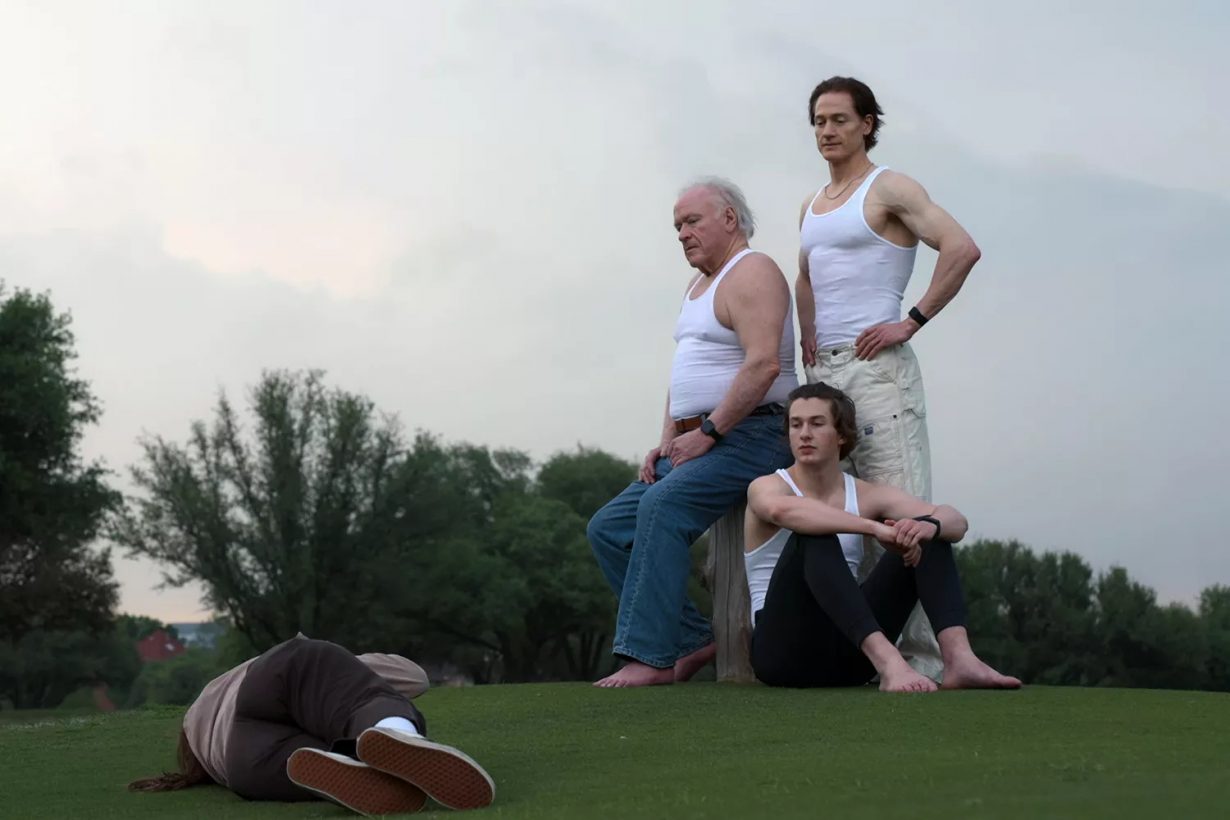Bryan Johnson wants to be ever young, Elon Musk wants to live on Mars and Artificial General Intelligence promises to facilitate it all – no matter the cost
After receiving his first round of follistatin gene therapy in Honduras’s Special Economic Zone of Próspera, the tech-centimillionaire Bryan Johnson stands with arms akimbo declaring: “I am now, officially, a genetically-enhanced human.” And: “From homo sapien to homo Deus.” He makes statements like these with the doubled sarcasm of your average tech entrepreneur trying to soften the hubris of his words. As a continuation of this bit, he asks both cameras (his own team’s and the documentary’s) to film him at an angle that will make his steps across the pool look as if he is walking on water.
In the new Netflix documentary, Don’t Die: The Man Who Wants to Live Forever (2025), we watch Johnson go about his life as prescribed by a protocol he calls ‘Blueprint’, a rigorous lifestyle regiment that claims to distil the finest pearls of wisdom ‘longevity science’ has to offer. Johnson is on a mission to live forever, and he spares no expense on his quest to pilot the latest and riskiest medical procedures he hopes will reverse aging and add years to his life. Devised with the help of ‘longevity consultant’ Oliver Zolman, Johnson’s personal Blueprint Protocol is continuously evolving in order to incorporate edgier and more experimental treatments, from off-label Rapamycin (an immunosuppressant commonly prescribed to organ transplant patients that, when taken off-label, is hailed as a ‘universal anti-aging drug’) to follistatin gene therapy (which, when injected into the abdomen, the Honduras-based clinic claims can improve ‘tissue composition and extend the lifespan in healthy mice by 32.5 percent’ – human trials pending). At 47, Johnson is the archetypical tech millionaire: ambitious, obsessively committed to “the science”, and fixated on a messianic, humanity-saving mission. The film opens with his explanation that, “as a species, we accept our inevitable decay, decline and death. I want to argue that the opposite should be true.” He problematises death and aging as archaic human practices, as opposed to facts of biology.
Johnson’s solution is a technological one: “And I’ve now built an algorithm that takes better care of me than I can myself.” He uses the word ‘algorithm’ to describe the Blueprint Protocol, a set of practices that are determined by Johnson and a team of 30 doctors and longevity consultants who weigh the findings of emerging research. Computation here is merely metaphor: the documentary itself does not discuss a specific set of technologies or softwares that decide what is part of the protocol. But Bryan Johnson’s position as a tech entrepreneur is no mere coincidence. He invokes the language of computational technology as a means of lacquering his Protocol with the sheen of computerised objectivity. Less than a month before Don’t Die premiered on Netflix, Johnson appeared in Longevity Hackers (2024), a separate documentary about the tech world’s interventions in longevity science. Between interviews with Tony Hawk, Steve Aoki and Marc Cuban, Johnson chimes in with insights like: “The body is an engineereable system” and “Our ability to arrest aging is an inevitability.”

The Blueprint website sells a range of diet supplements (including one cheekily called ‘Snake Oil’) and at-home biomarker tests to measure your speed of aging and accumulation of microplastics. He also sells Ezra MRI scans that combine ‘advanced use of MRI, CT and AI powered technologies’. Though most of the scientists featured across both documentaries made it very clear that the best way to extend your healthspan – meaning the number of years you can live in relatively good health – is through diet, exercise and sleep. All the other interventions – the LED lights, the metformin, rapamycin, gene therapy, plasma transfusions, supplements – are speculative at best. At least, for now. But in that small pocket of possibility of the never-ending for now, in that perpetual striving for progression, that ever-moving goalpost, this business can thrive.
At its most visible and sensational, longevity research intersects with the equally hypervisible and sensationalist claims of AI accelerationism regarding the future of humanity. The entrepreneurs who appear in both documentaries use familiar rhetorical moves. They claim the future and its technologies are already here, but demand more investment and less regulation to catch up to an existential risk posed by machines that exceed human ability and understanding. Or the development of such technologies by anyone but the United States. These paralleled rhetorics speak to a deeper compatibility between some of both fields’ most outspoken stakeholders. Artificial General Intelligence (AGI) – a type of theoretical AI that can outthink and outperform humans across a wide range of activities – is often promoted as a key technology in the pursuit of expanded human lifespans. Like Elon Musk, Sam Altman and Marc Andreseen, Johnson is also vocal about the existential urgency of developing AGI. In a highlighted Instagram story, he explains: “We are giving birth to superintelligence.” Johnson is confident that “technology is evolving faster than anyone can comprehend” and predicts longer human lifespans will be linked with the acceleration of AI development. “‘Don’t Die’ is a new economic, political, social, ethical and moral system,” he says. “It’s what intelligence does when it becomes super.”
A paper published early last year traced the lineage of the ideologies that propel AGI development today: transhumanism, extropianism, singularitarianism, cosmism, rationalism, Effective Altruism and longtermism, known collectively as the TESCREAL bundle. The leading figures of AI development have all, at some point or another, identified as proponents of one or several of these ideologies. And the paper connects transhumanism and its focus on expanding human lifespans (among other forms of human enhancement) back to first and second-wave eugenics. The authors explain how ‘new eugenics claims to be “liberal”’ emphasising the freedom of parents to decide whether, and how, to produce “enhanced” offspring. Longtermism (an offshoot of Effective Altruism) builds on transhumanism and ‘emphasises the moral importance of becoming a new posthuman species’, a sentiment echoed in Johnson’s claim that, just as technology is evolving, we are also ‘evolving into something new as a species’.

We need only think about how unadulterated AGI acceleration already comes at too high a human cost. Rising fossil fuel consumption; biased and exploitative datasets; and rare earth ‘conflict minerals’ like tin, gold and cobalt, often extracted through environmentally devastating methods, to fund genocidal campaigns in places like Democratic Republic of Congo and Sudan. At their worst, longtermists have gone as far to justify ignoring ‘all the effects contained in the first 100 (or even 1000) years’ so long as the further-future stands to benefit. Yet there is nothing about how our world works today to indicate that a lunge towards expanding human lifespans will benefit the whole of humanity. In these documentaries, ‘future’ and ‘longevity’ are defined along the needs and desires of the usual handful of tech goblins that are all too gleefully burning through our world’s natural resources in their inexhaustible quest, before they leave all us non-billionaires to boil and drown once they’ve set off to colonise Mars. At their cruelest, these longevity-obsessed, AI-evangelising CEO’s are building and betting on a future that deliberately does not include most of us.
Up close, the quest for a superhuman-supercomputer hybrid can seem like one billionaire’s eccentricity. Who can argue against more time with pets and loved ones? Indeed, it is exciting to think of a future where nobody dies and computers do all the work. But as it stands, that future is shaping up to be a privilege afforded to a self-appointed elite at the rest of our expense. Indeed, AI is often presented as a sharp scythe to cut away at the collective power of the creative labor force – facilitating more and cheaper extraction from artists, actors, singers, writers and illustrators. It was supposed to do the hard work while we all spent time with our families and painted al fresco. As AI fails to deliver on meaningful sales or productivity metrics, the pivot to creative work signals towards a future where humans send the emails and the machines make the art.
Michelle Santiago Cortés is a writer and critic based in Puerto Rico
